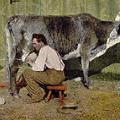 Cows were milked in the morning and evening. Before the advent of electricity and milking machines, the chore had to be done by hand. It took about an hour for two or three people to milk twenty cows.
Cows were milked in the morning and evening. Before the advent of electricity and milking machines, the chore had to be done by hand. It took about an hour for two or three people to milk twenty cows.
Cream was churned whenever there was a surplus of milk which the family could not consume. The extra milk was saved from three or four milkings, the cream was separated, and churning began. The churning was often assigned to the children on the farm once they were strong enough to pump the handle.
The butter that was produced was put into tubs and stored in the cellar, which usually had a dirt floor and racks for storage. The butter was saved for three or four weeks, then taken to the village store and exchanged for necessities that could not be produced on the farm. The family were paid for any surplus butter.
As more cows on the farm freshened (gave birth), the extra milk was strained, cooled, and sent in cans to the creamery. It was tested for butterfat content and the cream was taken off. A high butterfat content meant that a maximum amount of butter or cheese could be made from a fixed volume of milk. The skimmed milk came back to the farm, where it was then fed to calves or mixed with grain and fed to the swine.
There were creameries in towns all over the Eastern Townships. One such creamery was in Dunham. By 1946, the total output of products such as butter, cheese, and condensed milk by Eastern Townships dairy factories amounted to almost $17 million. This was well over one-fifth the provincial total. For many farmers, their main source of income was the cheque they recievd from the local creamery or butter factory. A 1921 pamphlet entitled "Eastern Townships of Quebec," published by the Quebec Ministry of Colonization, stated that dairy farming was (at that time) the most important industry in the region.